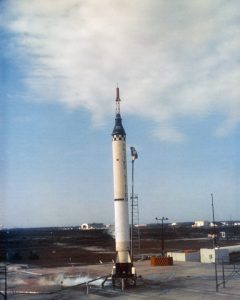It’s November 21, 1960, and it’s fifteen minutes before launch. Chris Kraft, the Mercury flight director, is a little nervous. He and his team have been preparing the past month, and it’s finally time to see if it works. Gene Kranz, a former Air Force fighter pilot, stands by, waiting to see what happens. Launch day is one of the most important parts of any project, but, with Project Mercury, most of the important lessons occurred during the project.

Project Mercury began in 1958, consisting of a small group of people in its earliest days. Since this was early in the United States space program, there was no established way to train someone to become an astronaut. So, some test pilots had to be hired, and a man named Gordo Cooper was one of them. “If you saw someone wearing a short-sleeved Ban-Lon sport shirt and aviator sunglasses, you were looking at an astronaut.”1 There were many people like this, and Kranz felt that this was good. He felt that people like John Glenn, Alan Shepard, and others, “[were] the best kind of [men] who [could become] military test pilots.”2 These pilots were soon going to have their glory in space history and in Project Mercury’s later projects. The goal of the project was to send the first man into space before the Soviet Union did. And this was the first major step to our sending a man to the moon, which was NASA’s goal of the decade. During the project’s lifespan, there were plenty of missions, such as the Mercury-Redstone 3, in 1961, and Mercury-Atlas 6, in 1962, where human space flight became a reality and where NASA began to catch up to the Soviet Union. However, before all that happened, there were some failures. Although what happened that November 21 can be considered a failure on the surface, Mercury-Redstone 1, which was to take-off that nerve-wracking morning, was still an important milestone in the context of the project.
Since rockets and spaceships are very large objects, it can be quite challenging to coordinate all of the complexities involved just to launch them. Much of the construction of these rockets was done by the McDonnell factory in St. Louis, which had a peak employment of over eight hundred workers.3 Since this was one of the first such projects, “every mission was a first, a new chapter in the book.”4 This meant that most things were being done for the first time; those involved had to expand on what was already known from existing aviation and rocket technology. Since the goal was to put a man in space, the team, including Kranz and some engineers, had to try and simulate astronauts in their first run of tests. They tried one or two tests with something called a “mechanical man.” It was a box of electronics that weighed about as much as an astronaut, and simulated the conditions that would be present if an astronaut was inside the capsule. The capsule sent back some pre-recorded messages to make sure that the communications worked well. After this proved successful, they transitioned to spider monkeys, then chimpanzees. Test flights worked well. The only issue they really had were limits in current knowledge. The team did not have manuals to use, so they had to figure out how to use most of the components.5
After these tests were successful, the team began to work on the protocol for launch day. Kranz notes that he immediately began to work with his team, setting “Go No-Go” points for telemetry display, command, and communications in Mercury Control. He then had to sync the Mercury Control Center (MCC) countdowns with the booster and capsule countdowns. Setting these countdowns, and making sure that every problem had a theoretical answer to it was key to a safe and successful launch. Kranz compared this new experience with aviation. To put it into perspective, airplanes usually fly at about five miles per minute. Now, imagine going five miles per second. Since the rocket is going much faster, “so many things [are] happening that [they would] not have any time for second thoughts or arguments.” After learning about what to do during a rocket launch, the team could begin to prepare for launch.6
The Project Mercury team members were under an immense amount of pressure. In August of 1960, the Mercury-Atlas 1 had a test launch, and it exploded in-flight, therefore rendering a load of problems for the team members. They had to find out why it exploded, figure out a solution, and then rebuild the rocket for retesting. The project was not going well at this moment. A journal titled Missiles and Rockets stated: “NASA’s Mercury manned satellite program appears to be plummeting the United States toward a new humiliating disaster in the East-West space race. The program is more than a year behind the original schedule… It no longer offers any realistic hope of beating Russia in launching the first man into orbit, much less to serve as an early stepping-stone for reaching the moon.”7. It must be hard for the project team members to continue with their work when people may not believe in the project itself, and feel that the Soviet Union may have won this race. However, the team was still motivated to prove everyone wrong, that the United States was as innovative, if not more innovative, than the Soviet Union.
The launch day for the Mercury-Redstone approached, and the team was coordinating and testing their launch sequencing. Their tests included checking to see that every member was doing what they were supposed to; if not, this was the perfect time to correct it. Kranz details what will be used in the first mission: a ballistic test of a Redstone booster rocket and a Mercury capsule. He describes the way the rocket launch should happen. The rocket would launch, and the engine would burn for two and a half minutes. Then, the escape tower would separate and the escape tower rocket would be ignited. It was projected that the Redstone would boost to an altitude of 130 miles until it would fall downward.8 All of this was planned to last sixteen minutes. Now that everyone on the team had an idea of how launch day would go, they felt they were prepared for this great milestone for NASA and Project Mercury.

Finally, fourteen days after the original planned launch date, November 21, 1960 had arrived. All team members were nervous yet excited to see the outcome of their hard work and dedication. Mercury Mission Control had a camera pointed at the rocket to document the launch day. With everything in place, the launch countdown began. Without any delays or hiccups, the rocket launched. An enormous amount of smoke covered the bottom of the rocket, and the camera was not able to see anything. “The expected blast momentarily churned the air around the launch complex. But then the roar stopped as suddenly as it had started. …the startled engineers saw the booster wobble slightly on its pedestal and settle back on its fins after, at the very most, a 3.8-inch liftoff.”9 After the premature shutdown, the escape tower was shot up into the air. It went up about 4,000 feet, and then proceeded to land about 1,200 feet from the launch pad. Since this all happened in a few seconds, everyone was panicked, unsure of what to do, since they had not prepared for something this substantially bad to happen. Kranz describes the situation from the Control Room: “The intercom that had been quiet was not busily filled with directions, observations, and opinions. Everything that had happened, although it had taken only seconds, passed before me in slow motion.”10

Everyone on the team was devastated. This was not what was planned, and it was a very disappointing outcome for the entire team. In a report by NASA, they investigated why the launch went so poorly, and had this statement: “Investigation revealed that a ‘sneak circuit’ through the control plug and ground network gave a pre-mature booster cutoff.”11 “It [was] determined that this two-prong plug is designed so that one prong disconnects about one-half inch before the second one does… The booster circuitry is such that if one of these prongs is disconnected prior to the other and while the booster is not grounded, a relay will close giving a normal engine cutoff signal.”12 Since the rocket had shutdown, the team quickly consulted on what to do next. The team proposed to reconnect the umbilical, but they had a live rocket on the launch pad; it was too dangerous. It was then suggested that they shoot the fuel tanks, but that was quickly disregarded. Then, after hearing plenty of ridiculous ideas, they decided it was best to wait until the next morning, when the batteries would have been depleted, before trying to disarm the system. After disarming, the team quickly looked for the issue that caused this sudden shutdown. They found that the issue “[was] believed to have been caused by a booster tail plug [that] pulled out about one inch after liftoff.”13 They made a couple of changes to the rocket, and were already ready to reschedule the launch day. After this, MR-1A was rescheduled for December 19, and other projects, such as MR-2 and MR-3, were delayed until sometime in 1961.
The primary mission “was to qualify the automatic inflight abort sensing system and the Spacecraft-launch vehicle combination for the Mercury ballistic mission. The mission included obtaining a velocity of Mach 6.0 during powered boost and successful separation of the space-craft.”14 As can be interpreted, the goals of this mission were not reached during this first four-inch launch. However, there was not any wasted time during the beginnings of the project. For launch day, everyone in the team thoroughly prepared for almost every possible situation, and this preparedness was applied in future projects within Project Mercury. For example, the flight Aurora 7 was a much more complex flight, in that it involved an astronaut for the first time, and therefore had more procedures to go over, yet was prepared for in about six months. MR-1 was Project Mercury’s first test flight after two years of work. There was plenty to learn from this experience, and even though it may have been difficult and tedious, it was all for the same goal: to get to the moon. We wanted to go to the moon, and if we wanted to do that, we had to go through these kinds of learning failures. As President John F. Kennedy famously said: “We choose to go to the moon in this decade and do the other things, not because they are easy, but because they are hard, because that goal will serve to organize and measure the best of our energies and skills…”15
- Gene Kranz, Failure Is Not an Option (New York: Simon and Schuster, 2001), 14. ↵
- Gene Kranz, Failure Is Not an Option (New York: Simon and Schuster, 2001), 15. ↵
- “Moving to the Launch Site,” https://history.nasa.gov/SP-4201/ch9-2.htm ↵
- Gene Kranz, Failure Is Not an Option (New York: Simon and Schuster, 2001), 2o. ↵
- Gene Kranz, Failure Is Not an Option (New York: Simon and Schuster, 2001), 20. ↵
- Gene Kranz, Failure Is Not an Option (New York: Simon and Schuster, 2001), 21. ↵
- Missiles and Rockets,” American Aviation Publications (1960) ↵
- Gene Kranz, Failure Is Not an Option (New York: Simon and Schuster, 2001), 26. ↵
- “MR-1: The Four Inch Flight,” https://history.nasa.gov/SP-4201/ch9-7.htm ↵
- Gene Kranz, Failure Is Not an Option (New York: Simon and Schuster, 2001), 30. ↵
- “The Mercury-Redstone Project,” https://ntrs.nasa.gov/archive/nasa/casi.ntrs.nasa.gov/19670028606.pdf ↵
- “MR-1: The Four Inch Flight,” https://history.nasa.gov/SP-4201/ch9-7.htm ↵
- “MR-1: The Four Inch Flight,” https://history.nasa.gov/SP-4201/ch9-7.htm ↵
- “The Mercury-Redstone Project,” https://ntrs.nasa.gov/archive/nasa/casi.ntrs.nasa.gov/19670028606.pdf ↵
- “JFK Rice Moon Speech,” https://er.jsc.nasa.gov/seh/ricetalk.htm ↵



16 comments
Nathan Alba
I guess at the time, many people must have been upset with the result. Especially with all that was going on with Russia at the time. However, even though we did lose that “battle” we did end up beating Russia to the moon. It does have to be hard on the team, so much goes into prepping a mission of this magnitude, and with the limited technology at the time, it is by no means an easy task. Unfortunate the unsuccessful may ave been, but in the end making all these mistakes would further the US knowledge to make even further leaps in the future.
Jose Fernandez
I didn’t know about this mission, and I think it is interesting that the mission failed several times, given that they did so many tests. I think this story shows the importance of testing when it comes to dangerous experiments. NASA had the best scientists and engineers in the world and they still struggled to succeed. I really enjoyed reading this article and I can tell it is really well researched.
Didier Cadena
This was a very interesting article. I had never heard about the Mercury Redstone 1 failure, so it was nice to read about it. I was unaware about how much time we spent trying to get people on the moon. These tests are a great example for learning from your mistakes. The article does a great job of formatting the information in a way that is enjoyable to read.
Bictor Martinez
This article was an interesting read. It is unreal to think the amount of time and work these guys had, to get men on the moon. These men were able to learn from their fail flights and use it as fuel for the next one. I find it extremely difficult to find the problem if a spaceship were to explode. So many options to tell from, that one cannot know what could have caused the problem. I agree with Kennedy’s saying towards the end because we challenge ourselves to help sharpen and challenge our skills to make the best person out of ourselves.
Reagan Meuret
This is just a perfect example of the expression “learn from your mistakes”. This article did a good job of simplifying some of the science related things I would not have understood. I just found it very cool how they were able to not only figure out exactly what was wrong with the rocket but immediately begin learning how and why that all took place. These guys determination are a good part of the reason why America was able to put men on the moon.
Alexander Manibusan
Imagine all of the calculations made and scratched out and then remade in order to launch the first rockets into orbit. All of those geniuses that put in so much hard work to make something fly into space. Exactly what was it like to make the designs for project Mercury? Now I know that this was unprecedented, but I find it baffling (perhaps a bit amusing) that there wasn’t any standardized training for an astronaut back then.